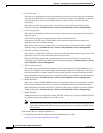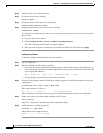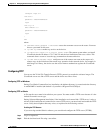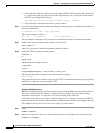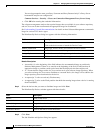
12-52
User Guide for Resource Manager Essentials 4.1
OL-11714-01
Chapter 12 Managing Software Images Using Software Management
Software Distribution
• Look in the file /etc/inetd.conf for the line that invokes TFTPD. If the line begins with a pound sign
(
#), remove the pound sign with your text editor. Depending on your system, the line that invokes
the TFTP server might look similar to:
tftp dgram udp wait root /usr/sbin/in.tftpd in.tftpd -s /tftpboot
• Save the changes to the edited file and exit your text editor.
Step 3 Go to the UNIX prompt, enter the following command to display the process identification number for
the inetd configuration:
# /usr/bin/ps -ef | grep -v grep | grep inetd
The system response is similar to:
root 119 1 0 12:56:14 ? 0:00 /usr/bin/inetd -s
The first number in the output (119) is the process identification number of the inetd configuration.
Step 4 Enable your system to read the edited /etc/inetd.conf file, enter:
# kill -HUP 119
where 119 is the process identification number identified in Step 3.
Step 5 Verify that TFTP is enabled by entering either:
# netstat -a
or
# grep tftp
which should return output similar to:
*.tftp Idle
or enter:
# /opt/CSCOpx/bin/mping -s tftp localhost_machine_name
which returns the number of modules sent and received, for example:
sent:5 recvd:5 . ..
If the output shows that zero modules were received, TFTP is not enabled. Repeat these steps, beginning
with Step 1, to make sure you have enabled TFTP.
Creating the /tftpboot Directory
RME uses the /tftpboot directory when transferring files between the RME server and network devices.
The files are removed after the transfer is complete. However, multiple jobs (for example, image
distribution, image import, or config file scan) could be running at the same time.
Each of these jobs requires its own space. Software image sizes, for example, can be up to 20 MB. To
ensure that jobs run successfully, make sure there is sufficient space available in the /tftpboot directory.
If the /tftpboot directory does not exist on your system, you must create it:
Step 1 Enter:
# mkdir /tftpboot
Step 2 Make sure all users have read, write, and execute permissions to the /tftpboot directory by entering:
# chmod 777 /tftpboot





